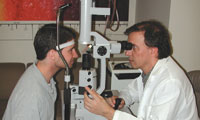DeepLight offers potential for more selective tissue ablation
 Patient being treated with TiSaLT. Photograph courtesy of Gabriel Simon, MD, PhD. |
Laser trabeculoplasty using a new titanium sapphire device allows deeper penetration of clogged tissue with less scarring than argon laser trabeculoplasty and deeper penetration than other currently available modalities, according to a glaucoma surgeon who conducted a pilot study with this treatment.
The 790-nm wavelength of Solx’s DeepLight laser provides approximately four times more tissue penetration than selective laser trabeculoplasty (SLT), allowing surgeons to treat not only the trabecular meshwork but also the uveoscleral pathway, according to Gabriel Simon, MD, PhD.
In titanium sapphire laser trabeculoplasty (TiSaLT), surgeons employ an infrared laser to create spots around 180º of the trabecular meshwork at a depth of 200 µm.
The laser energy targets and is absorbed by pigment, inciting shock waves through the tissue, ablating the tissue and unclogging blocked passageways. Like SLT, which uses a green laser to target pigmented tissue, the procedure causes minimal thermal damage and can be repeated if necessary, Dr. Simon said.
Pilot study
In the pilot study of TiSaLT, Dr. Simon treated 68 eyes of 57 patients with optic nerve damage due to primary open-angle glaucoma and inadequately controlled IOP. Patients were treated at the Instituto Oftalmico Gabriel Simon in Barcelona and Madrid.
Patients were classified into four groups: high-risk (nine eyes being treated with three or more medications), normal-risk (20 eyes on two or fewer medications), prior failed ALT (10 eyes) and re-treated TiSaLT (five eyes, including one with prior failed ALT). All eyes were taken off medication 10 days prior to treatment and continued without medication until medical judgment indicated introduction of medical management was needed.
Dr. Simon collected 12 months of data on 43 eyes and 18 months of data on 38 eyes. Two high-risk eyes and one normal-risk eye exited the study for surgery before the 6-month follow-up.
Procedure
Under topical anesthesia, eyes receive laser energy through a slit-lamp ophthalmoscope and a handheld Goldman three-mirror goniolens, according to the study. A red He-Ne laser is employed as an aiming beam.
Treatment begins with the administration of low energy pulses (25 mJ to 50 mJ) 8 ms in duration. Dr. Simon then increases the energy in 25 mJ increments until a clinically significant effect is achieved (slight movement of the treated structures, depigmented spots of roughly 200 µm, the appearance of “micro-bubbles” in the meshwork, or slight audible feedback).
At 12 months, mean postoperative IOP was 17.5 ± 2.4 mm Hg, compared to 25 ± 3.9 mm Hg preoperatively.
In addition, 60.4% of eyes had achieved the ideal “compliance free” outcome, requiring no further medication. Among prior failed ALT eyes, none required more than one medication postoperatively (with a mean of 0.3 medications). All of the eyes that had two treatments within the first 2 weeks achieved the ideal outcome.
Doug Adams, founder and chief executive officer of Solx, noted that there are currently 10 DeepLight systems being used in Europe. The European Union granted DeepLight the CE Mark in November 2003.
For Your Information:
- Gabriel Simon, MD, PhD, can be reached at C/Minerva 7, Barcelona 08006 Spain; +34-93-218-4588; fax: +34-93-218-9435; e-mail: iogs_bcn@wanadoo.es.
- Doug Adams can be reached at Solx, 8 Saint Mary’s Street, Boston, MA 02215 U.S.A.; +1-978-443-0742; e-mail: doug@solx.com.
